Belfast’s Titanic Quarter stands on part of the shipyard where the ill-fated vessel was built and is one of the world’s largest urban-waterfront regeneration projects. The 185-acre (75 hectare) site includes Titanic Studios, Belfast Harbour Marina, and hotel, office, education, retail and apartment complexes. The district also is home to a number of excellent nautical exhibits, including the Titanic Belfast museum that describes the construction, loss and underwater discovery of the Titanic; the SS Nomadic, a tender to the Titanic and the only surviving White Star vessel; the Thompson Graving Dock, where the Titanic was dry-docked during construction; and the HMS Caroline, the only surviving ship from the World War I Battle of Jutland.
Below are trip highlights from October 25th and 26th, 2017 in Belfast, Northern Ireland. Click any image for a larger view, or click the position to view the location on a map. And a live map of our current route and most recent log entries always is available at http://mvdirona.com/maps
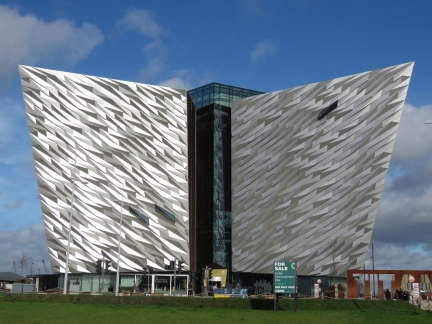 |
Titanic Belfast
Position: -5 54.61, 54 36.42
The striking Titanic Belfast museum was built at the head of the slipway where the ill-fated RMS Titanic was launched in May of 1911. The multi-media exhibit describes the construction, loss and underwater discovery of the Titanic and details Belfast’s shipbuilding heritage. Viewed from above, the museum building forms the logo of the White Star Line, the company that owned Titanic and its sister ships Olympic and Britannic.
|
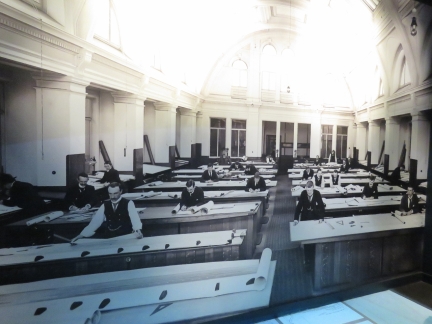 |
Drawing Office
Position: -5 54.57, 54 36.49
The exhibit included many historical photographs. We were amazed at the size and scope the Harland & Wolff drawing offices where over 1,000 ships, including Titanic, were designed.
|
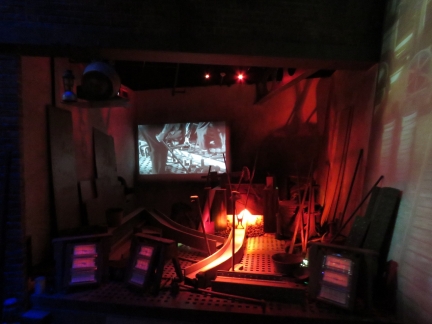 |
Shipyard Ride
Position: -5 54.57, 54 36.49
Part of the exhibit was a multi-level amusement-park-style ride through a realistic recreation of the H & W shipyard.
|
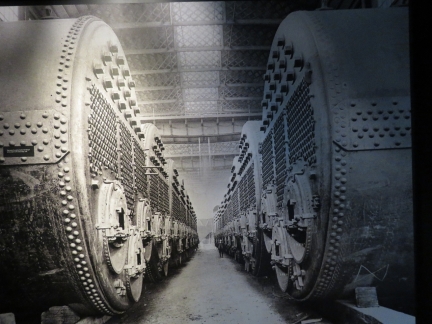 |
Boilers
Position: -5 54.59, 54 36.52
Everything about Titanic, an Olympic-class vessel, was on a massive scale. This photograph shows two rows of boilers for sistership Olympic. For scale, note the person standing partway along on the right.
|
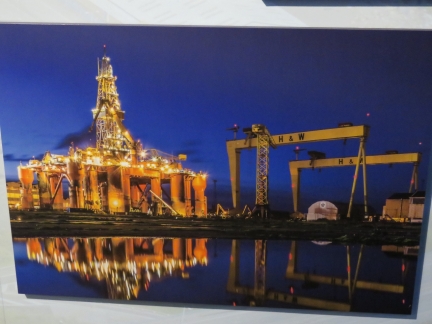 |
Byford Dolphin
Position: -5 54.59, 54 36.50
Titanic builder Harland & Wolff still is in business, but with shipbuilding in decline has branched out to other industries. They recently refit the massive oil rig Byford Dolphin, shown towering about the famous H & W gantry cranes Samson and Goliath in this dramatic night photograph on display at the Titanic Belfast museum. The Byford Dolphin stands 355ft high, weighs around 12,000 tonnes, can drill to about 20,000 ft (6,000 m) and can operate in water as deep as 1,500ft (460 m).
|
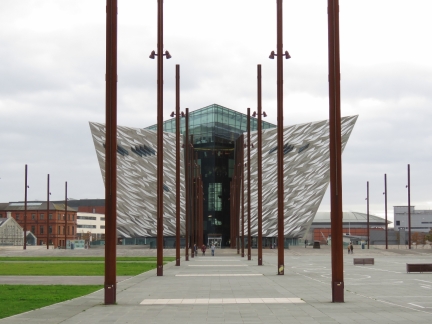 |
Slipways
Position: -5 54.50, 54 36.63
Looking to the Titanic Belfast exhibit along the Titanic Slipways Memorial where the the Titanic, Olympic and Brittanic were built and launched. The memorial includes lamp posts positioned where the gantry cranes once stood and a full-sized outline of Titanic and Olympic where they were built side-by-side.
|
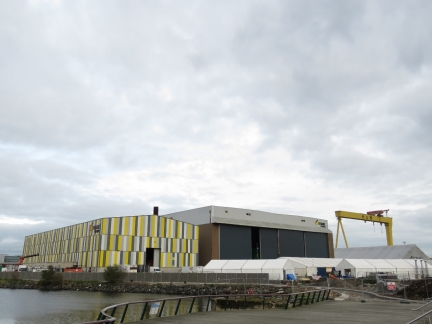 |
Titanic Studios
Position: -5 54.50, 54 36.63
The Titanic Studios buildings viewed from the end of the Titanic Slipways.
|
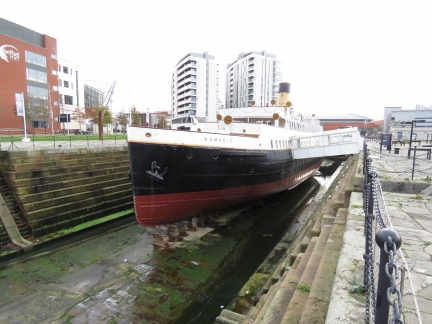 |
Nomadic
Position: -5 54.64, 54 36.41
SS Nomadic was a tender to RMS Titanic and the only surviving White Star vessel. Titanic and Olympic were too large to dock in France’s Cherbourg harbour, across the English Channel from the UK, so White Star commissioned the Nomadic to transfer passengers and cargo between ship and shore. The vessel was recently restored and now is on display at historic Hamilton Graving Dock adjacent to the Titanic Belfast exhibit.
|
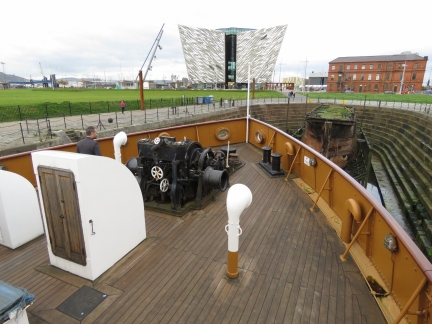 |
Bow
Position: -5 54.65, 54 36.39
Looking across the bow of SS Nomadic to the Titanic Belfast exhibit. The buildling on the right is the old Harland & Wolff offices, including the drawing office, which have recently been converted to a hotel.
|
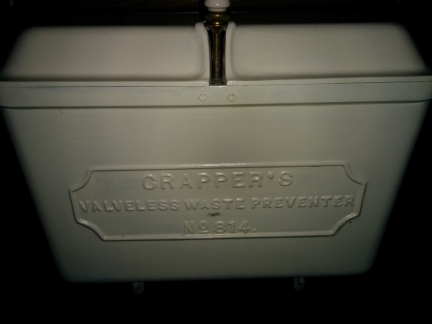 |
Crapper’s
Position: -5 54.66, 54 36.38
We had to take a photo of the toilets on Nomadic: original Valveless Waste Preventers built by Thomas Crapper.
|
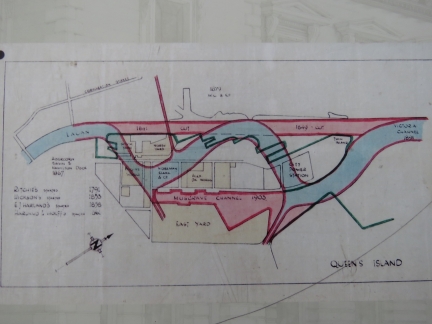 |
River Reroute
Position: -5 54.70, 54 36.38
The Lagan River was rerouted several times to ease passage and reclaim land. The blue line shows the original river path and the red line shows the waterways by 1903.
|
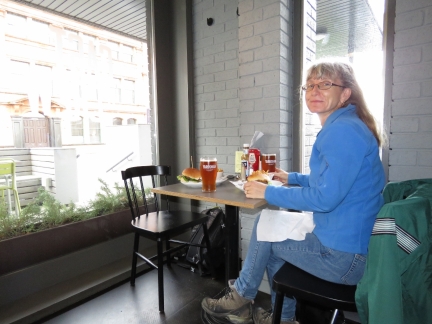 |
Cast & Crew
Position: -5 54.50, 54 36.45
A delicious burger at Cast & Crew near Titanic Studios in the Titanic Quarter.
|
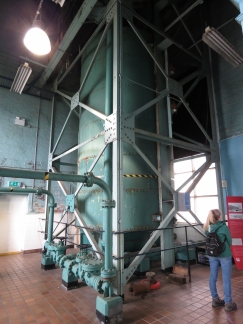 |
Accumulator Block
Position: -5 54.09, 54 36.88
Jennifer standing next to a hydraulic accumulator in the pump house for the Thompson Graving Dock, where the Titanic was dry-docked during construction. Compressor pumps in the floor lifted the huge riveted cylinder. When lowered, its 78-ton weight forced water through pipes, generating hydraulic pressure to open the dock gate and operate capstans around the graving dock.
|
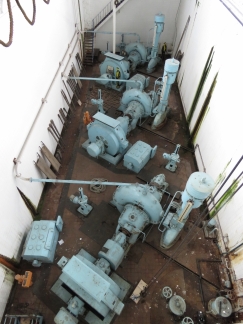 |
Gwynnes Pumps
Position: -5 54.10, 54 36.87
The original Gwynnes Pumps at the Thomson Graving Dock were the most powerful in the world when installed in 1911 and could empty the 21 million gallons of water from the dry dock in only 100 minutes.
|
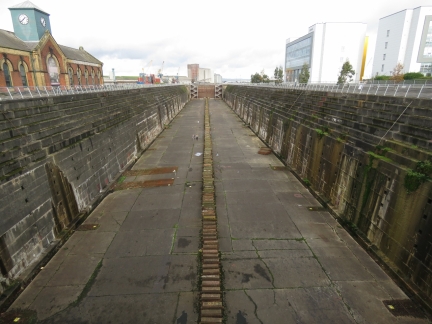 |
Thompson Graving Dock
Position: -5 54.08, 54 36.84
The Thompson Graving Dock was built to handle the mammoth White Star liners Titanic and Olympic. At 850 ft (259 m) long, it was the biggest in the world when it opened in 1911. Titanic was dry-docked here in 1912 for painting and propeller installation. The people just barely visible walking halfway along the floor to the left of the keel blocks give an idea of the scale. Even with such an immense dock, the Titanic completely filled it.
|
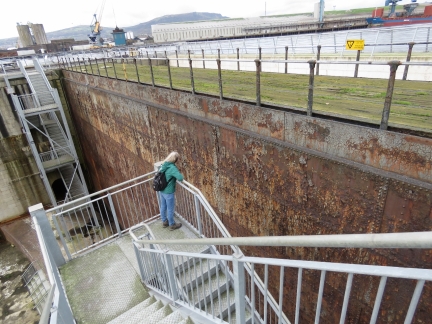 |
Caisson Gate
Position: -5 54.00, 54 36.98
A 1,000-ton caisson gate holds the water out of the dry dock.
|
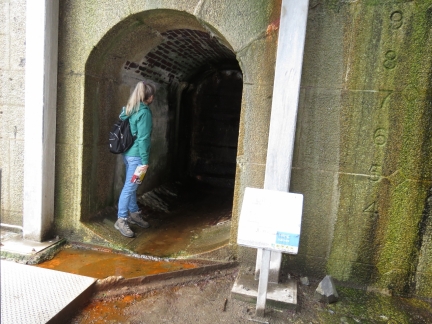 |
Filling Valves
Position: -5 54.02, 54 36.98
Jennifer standing in one of the Penstock Filling Valves used to flood the dry dock when work was complete. Refilling the dock took two hours, compared to only 100 minutes to empty it.
|
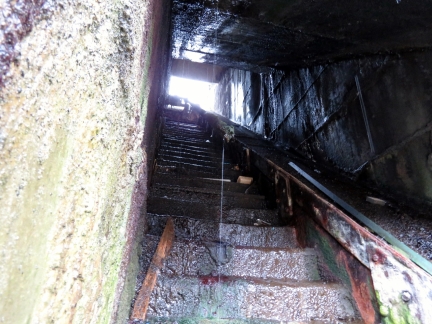 |
Stairs
Position: -5 54.06, 54 36.89
Several sets of stairs lead up from the dry dock floor to ground level at various points. The adjacent slides are for transporting equipment and tools up and down.
|
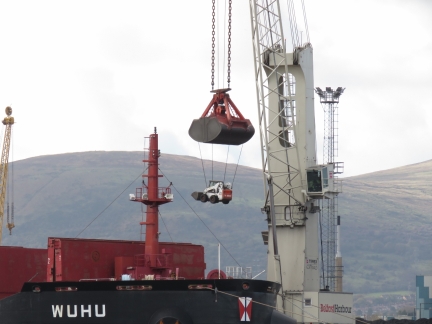 |
Bobcat
Position: -5 54.06, 54 36.96
After touring the Thomson Graving Dock and Pump House, we watched a bulker that had been unloading coal all day across the River Lagan at Belfast Harbour. The shovel is amazingly effective at picking up massive volumes, but we were both wondering how they would get the boat close to empty with that big shovel. As efficient as the shovel is at taking big scoops, it will leave a lot in the bottom of the hold. Here’s the answer: the shovel lowerered a Bobcat into the hold and used it to help get the last of the bulk cargo out.
|
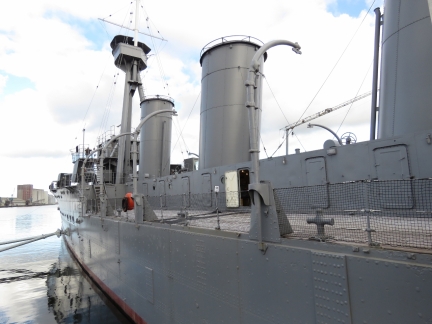 |
HMS Caroline
Position: -5 54.17, 54 36.83
The HMS Caroline, part of the Royal Navy National Museum, is the only surviving ship from the World War I Battle of Jutland. The ship is moored in the historic Alexandra Dock, completed in 1889 and used extensively by Harland & Wolff shipbuilders.
|
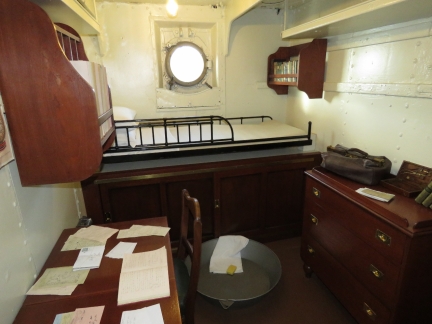 |
Interior
Position: -5 54.16, 54 36.82
The HMS Caroline curators have done an excellent job in preserving the ship and recreating it as it was in World War I, along with detailed displays and an informative audio tour. We spent ages inside.
|
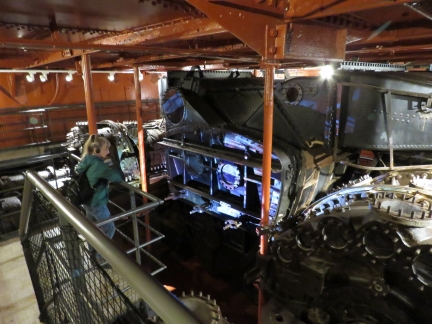 |
Engine Room
Position: -5 54.16, 54 36.82
Nearly every part of the Caroline was accessible, and the engine rooms were a particularly interesting part of the tour. The Caroline has 4 large direct- drive Parsons turbines that can deliver 40,000 shaft horsepower through 4 props to propel the Caroline to 28 kts. The turbines and condensers are cleaned and well lit so you can see many of the details. What we found particularly interesting is the approach the Caroline designers took to the challenge of delivering both 28 kts with 4 turbines running flat out and yet still be able to achieve efficient operation and reasonable range when not running at full speed.
In addition to the 4 main turbines, the designers added two small turbines that drive two of the prop shafts through a reduction gear. At low speed, the Caroline can run efficiently with two props idle and the other two props driven by two small steam turbines through individual gear boxes. At speed, 4 large direct drive turbines do the work. It’s both a slow but efficient two-turbine boat, and a fast but power-hungry four-turbine boat. |
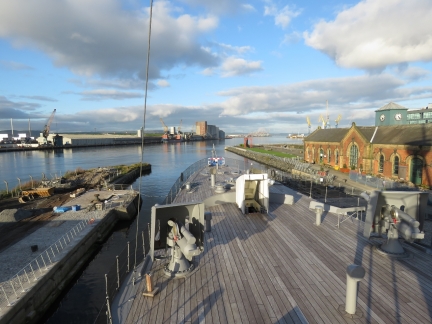 |
Bridge
Position: -5 54.15, 54 36.85
The view to Belfast Harbour from the bridge of the HMS Caroline. The brick building on the right is the pump house for the Thomson Graving Dock.
|
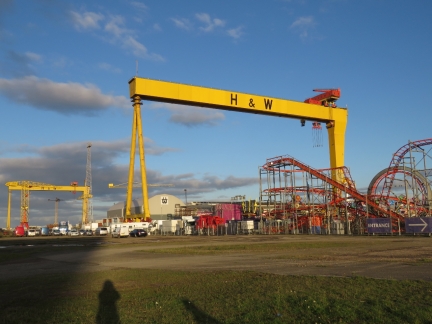 |
Samson and Goliath
Position: -5 54.54, 54 36.26
The evening sun lighting up the H & W gantry cranes Samson and Goliath. Goliath in the foreground is 315 ft (96 m) tall and dwarfs the amusement park roller coaster installed beneath it. Sampson is even taller at 348ft (106m).
|

|
Click the travel log icon on the left to see these locations on a map, with the complete log of our cruise.
On the map page, clicking on a camera or text icon will display a picture and/or log entry for that location, and clicking on the smaller icons along the route will display latitude, longitude and other navigation data for that location. And a live map of our current route and most recent log entries always is available at http://mvdirona.com/maps. |

If your comment doesn't show up right away, send us email and we'll dredge it out of the spam filter.